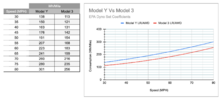Do you find the Monroney sticker laughably deficient in technical details ?
This pdf is for you. It is the (I think) full CSI document for the AWD and Performance models
I found the cold weather testing information most interesting. I also expected to find the SC06 cycle data since I thought that was part of the 5 cycle regime but perhaps Tesla only used 3 cycles ?
One other detail sure to spark interest: the document says the P model has some 4.5 kWh more battery than the AWD. I haven't sat down to see if the other data is consistent with that difference or if it is a typo.
This pdf is for you. It is the (I think) full CSI document for the AWD and Performance models
I found the cold weather testing information most interesting. I also expected to find the SC06 cycle data since I thought that was part of the 5 cycle regime but perhaps Tesla only used 3 cycles ?
One other detail sure to spark interest: the document says the P model has some 4.5 kWh more battery than the AWD. I haven't sat down to see if the other data is consistent with that difference or if it is a typo.



